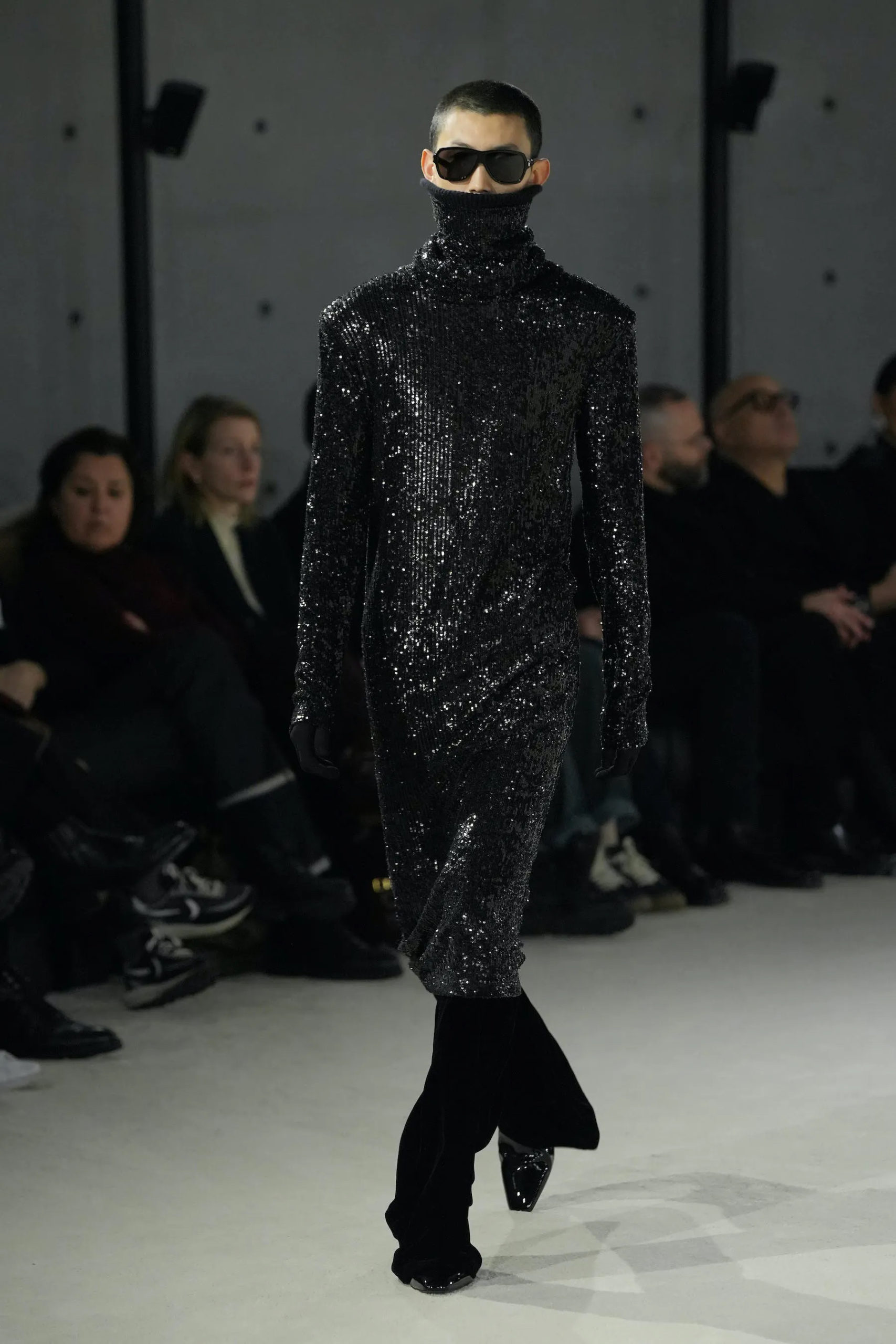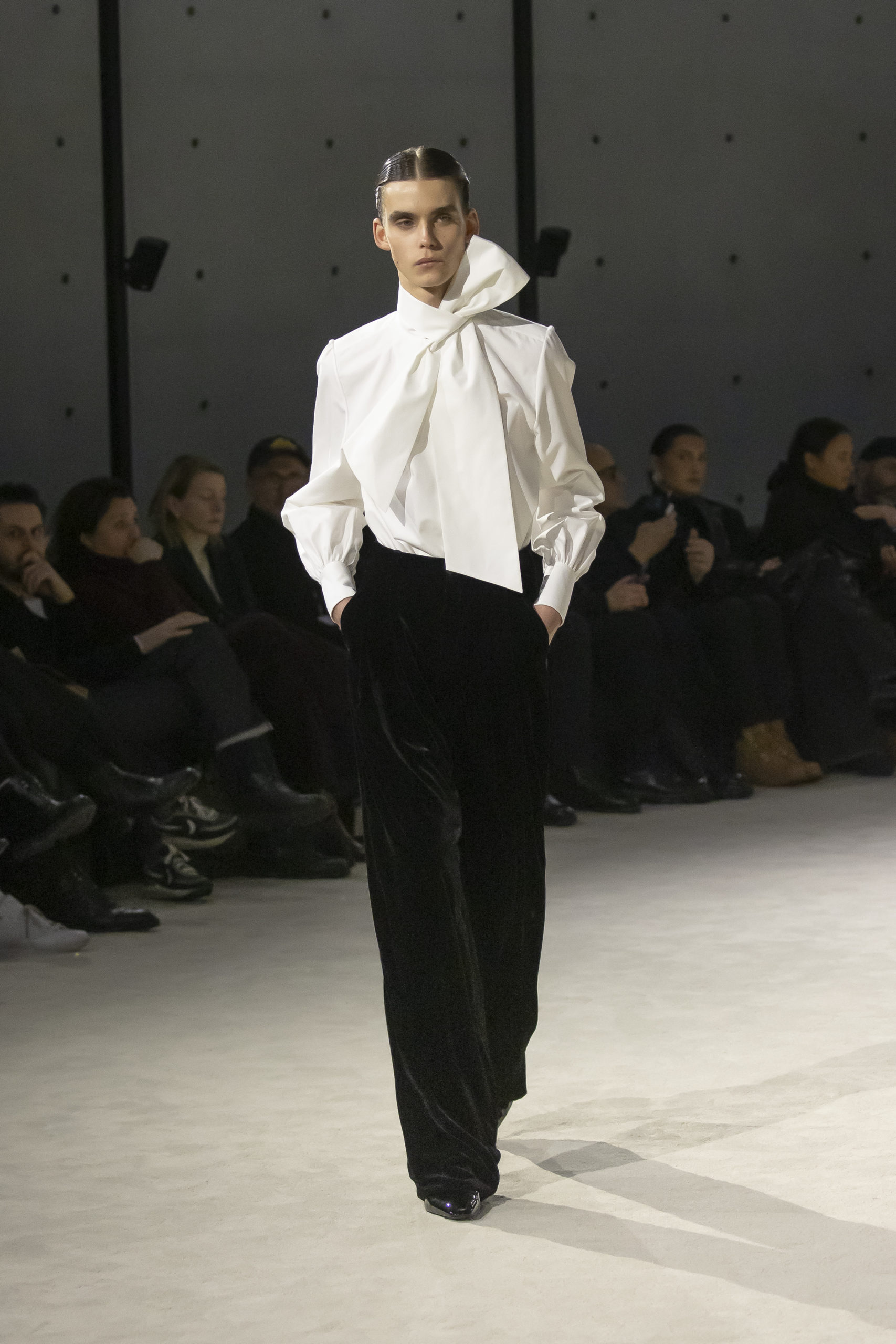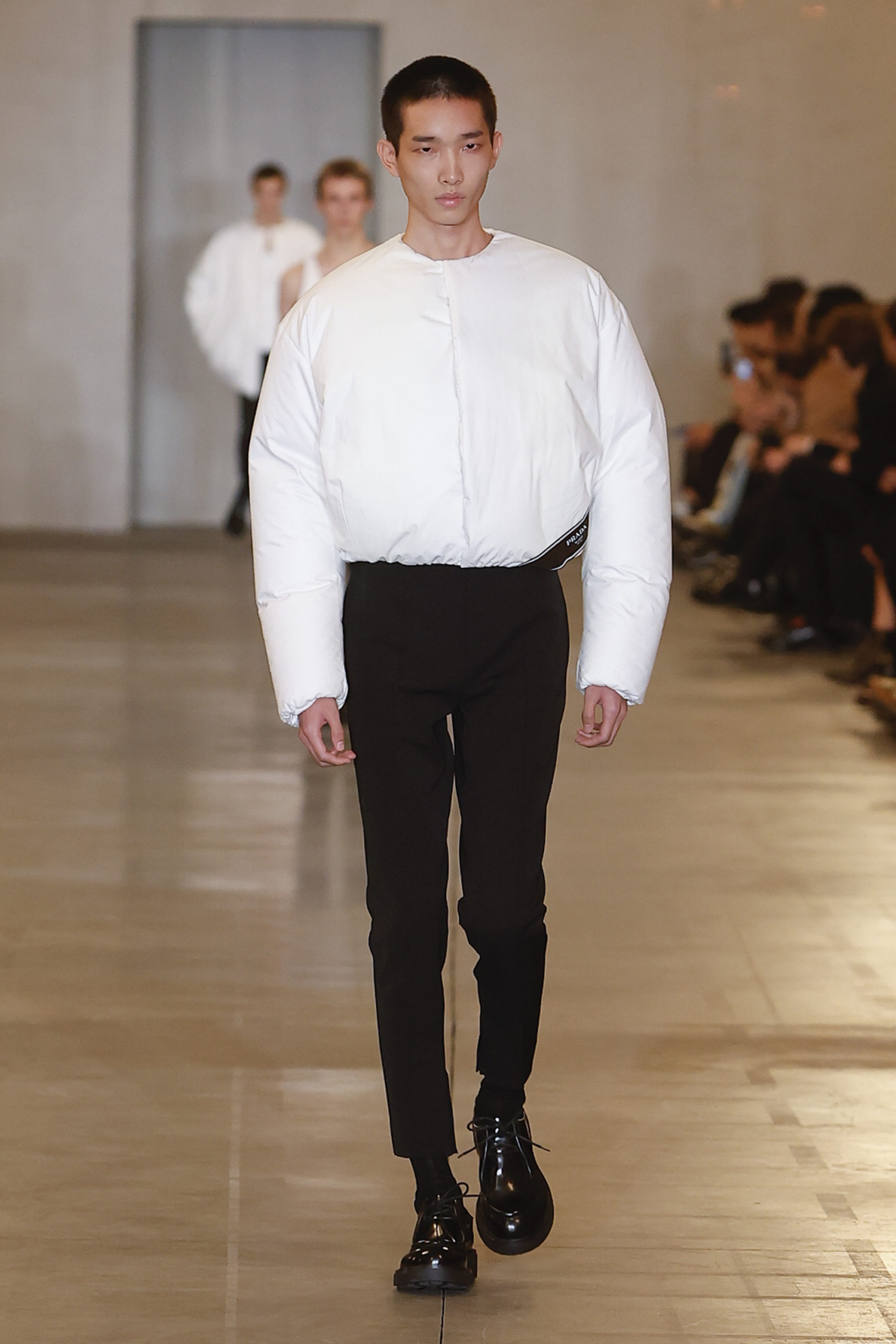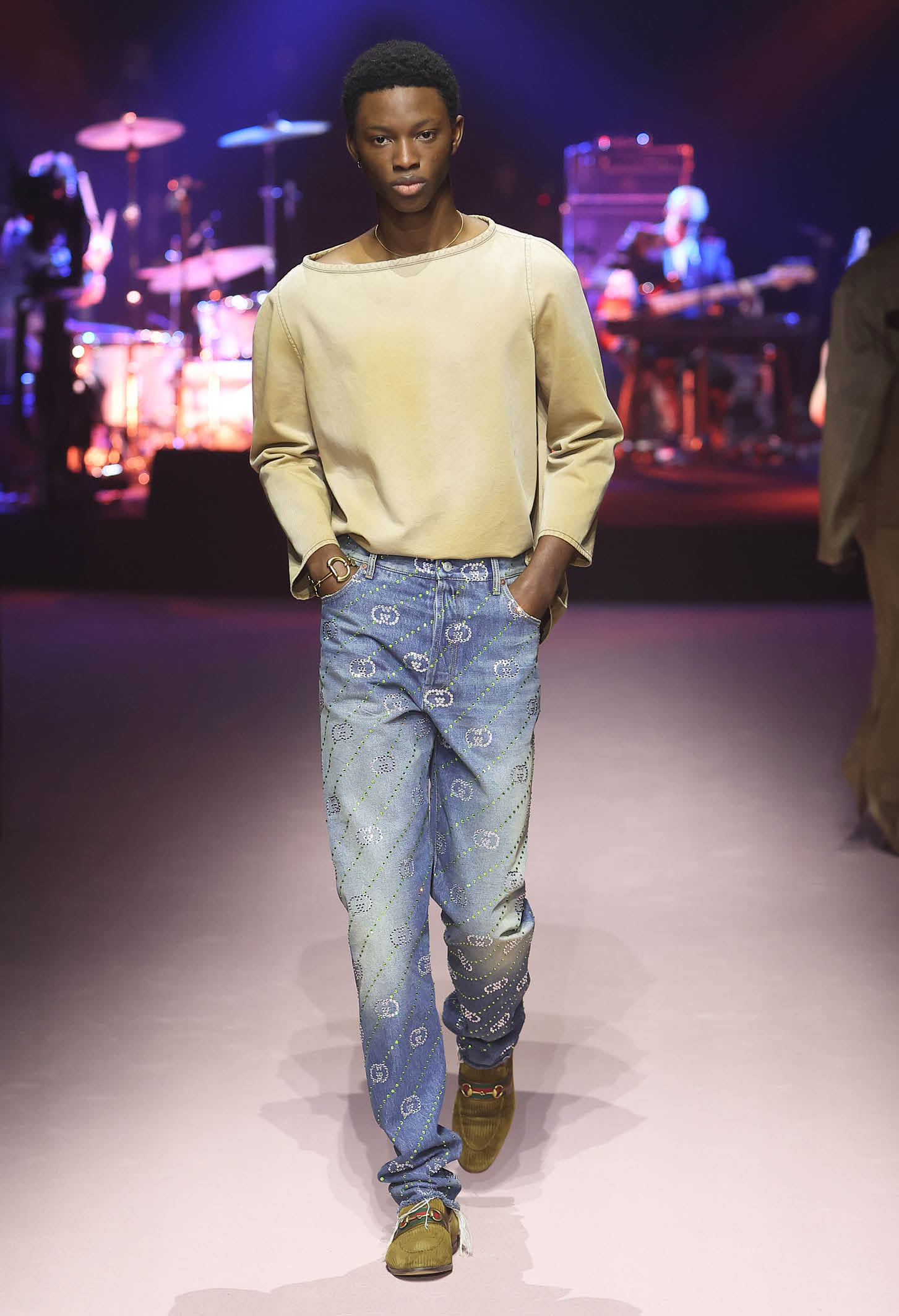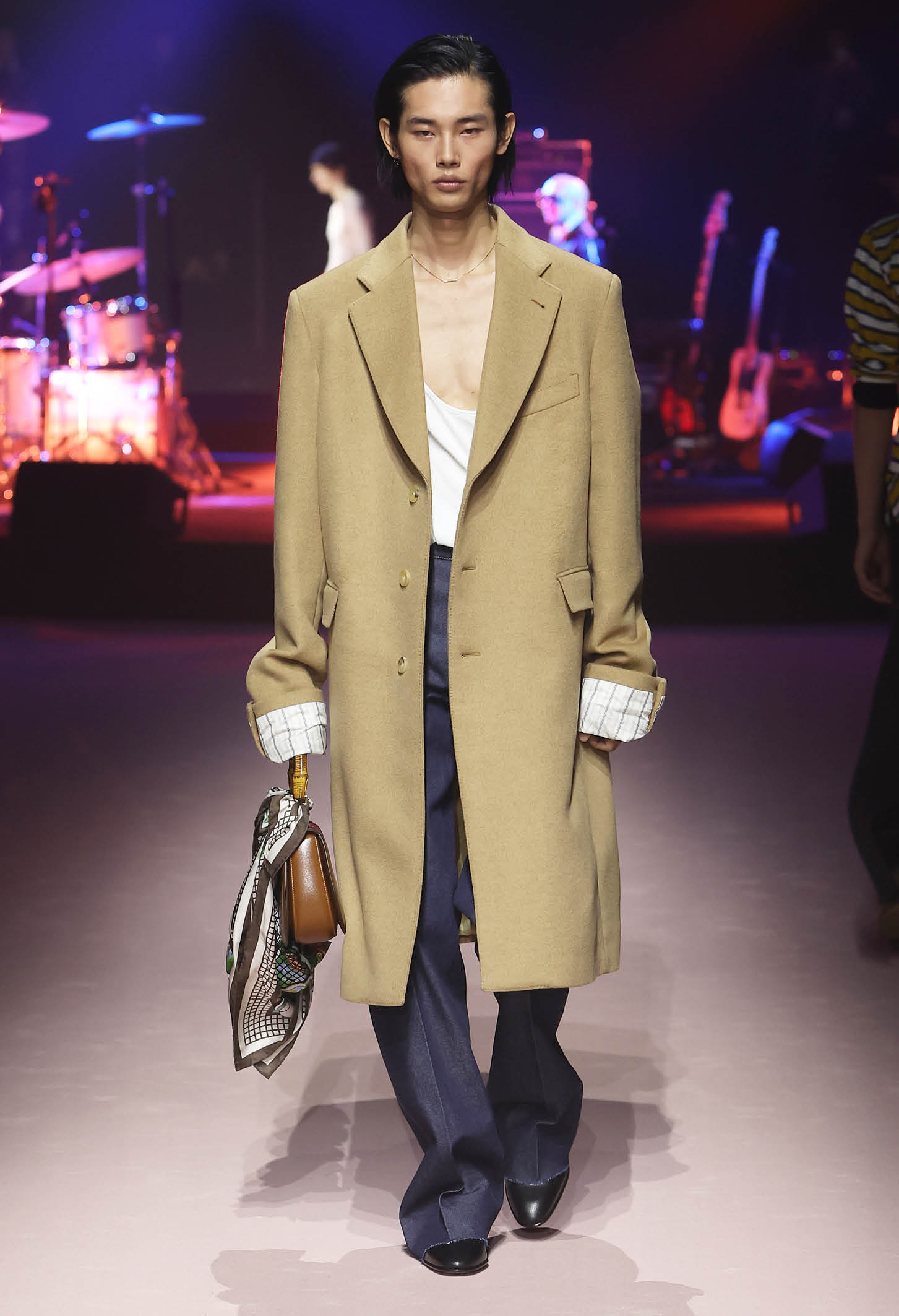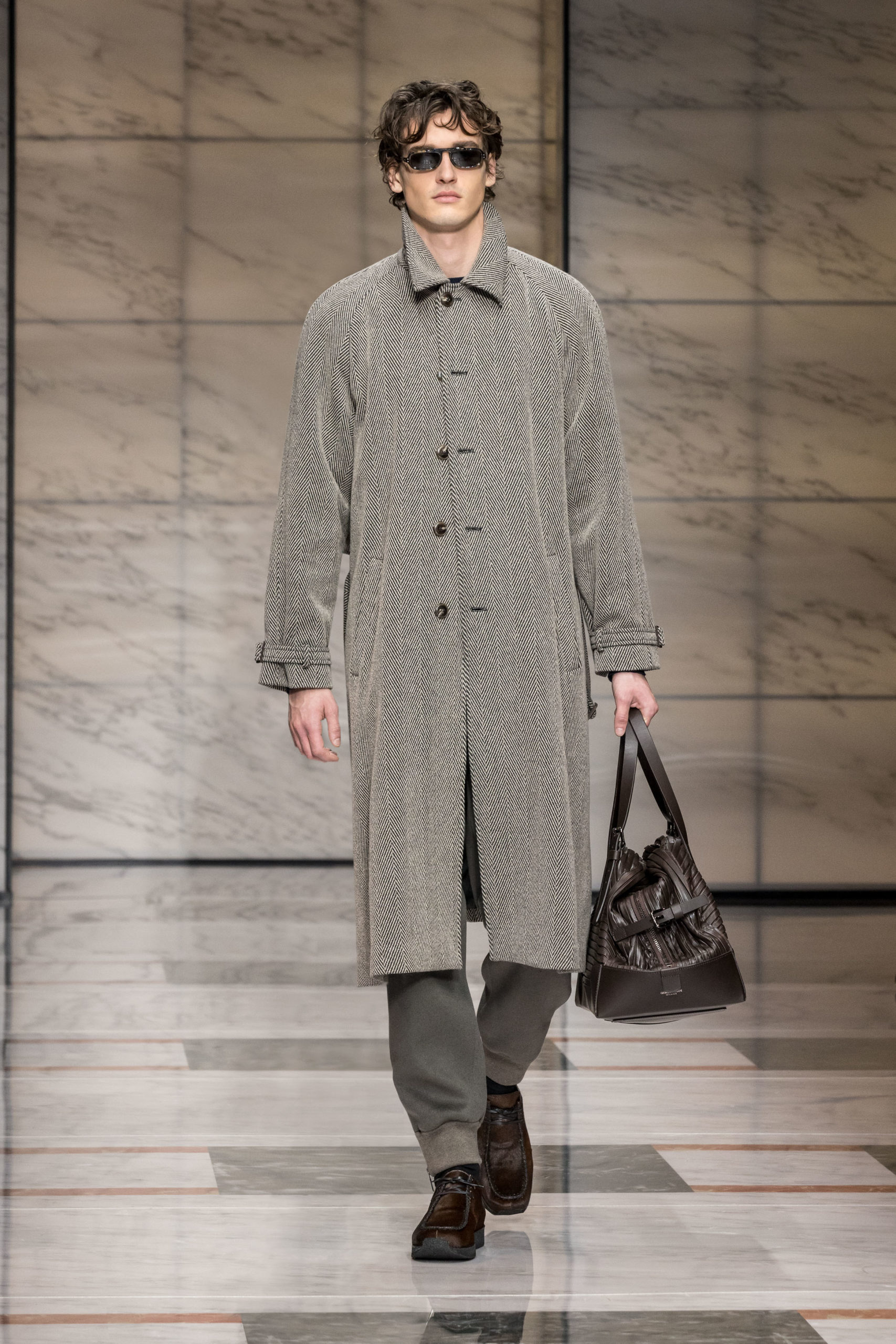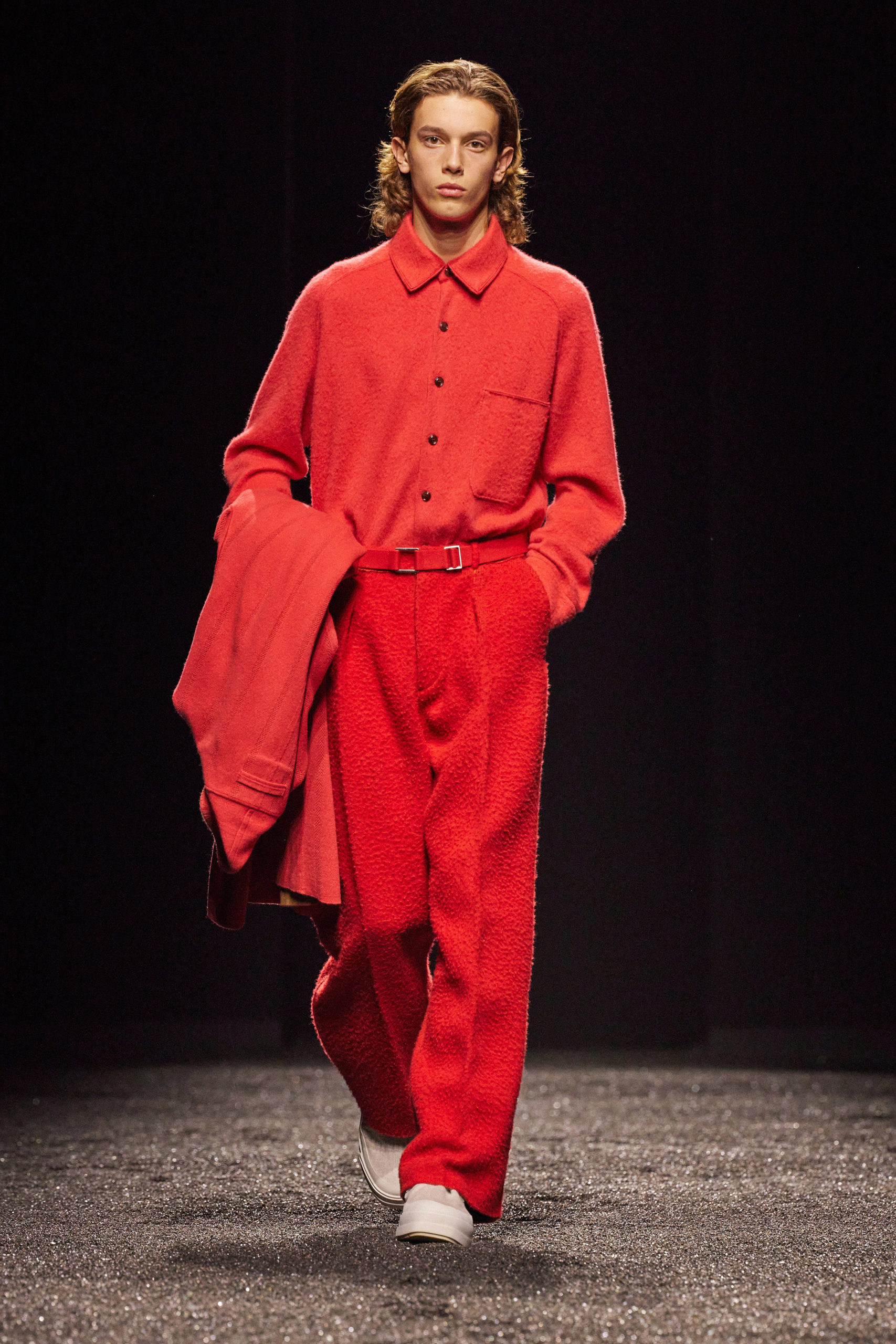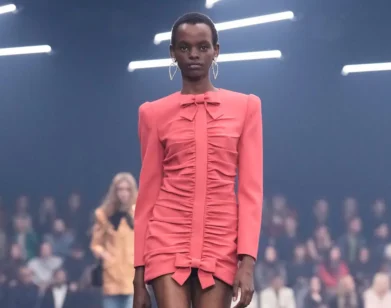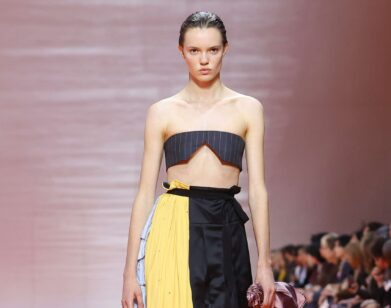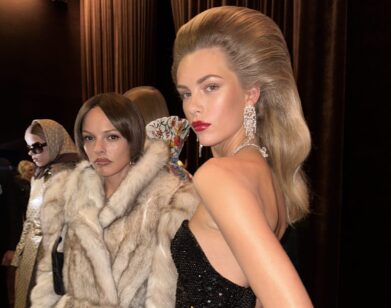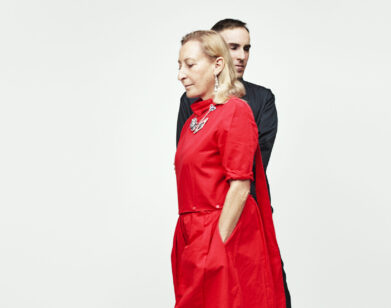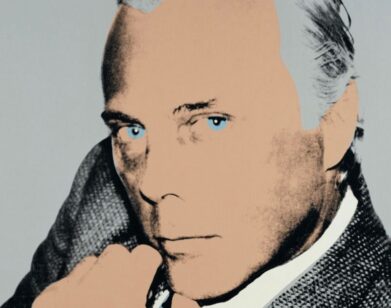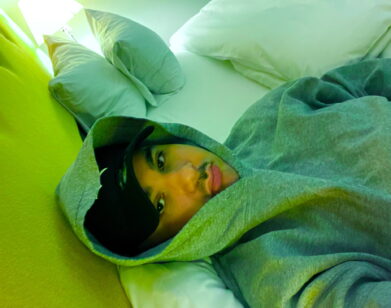MEN'S WEEK
Alexander Fury and Mel Ottenberg on the “Big Dick Energy” at the Men’s Shows
I’m not in Paris and Milan for the men’s shows this week because we’re closing our March issue and things are insane at the office. Alexander Fury was sending me videos of the best Saint Laurent looks walking in real time while I was getting my tooth fixed in NYC, causing a touch of show FOMO. I wanted to know everything about the best looks from a fave fashion bitch, so I called Alex for some front-row knowledge while in an Uber from the dentist to the Interview offices. Below, we talk Saint Laurent, Prada, Gucci, DSquared2, Armani, and Zegna.
———
ALEXANDER FURY: Can you hear me?
MEL OTTENBERG: Why is it so fucking low?
FURY: Wait a second. Is that any better?
OTTENBERG: No, it’s so low.
MEL OTTENBERG: We’re wearing matching outfits.
ALEX FURY: We are. I didn’t realize it was turtleneck season.
OTTENBERG: What’s your name?
FURY: Alexander Fury.
OTTENBERG: And what do you do?
FURY: I am the men’s critic of The Financial Times in London, and I’m also fashion features editor of another magazine called AnOther.
OTTENBERG: And you look very un-haggard, considering that you’re one week into the men’s fashion weeks.
FURY: Well there wasn’t much to do in Milan, so one day I slept 11 hours. It was great.
OTTENBERG: How many people do you think are on Ozempic that you saw there?
FURY: People have been telling me about it and then it sounds like it’s something that could be good. But I read that it causes muscle wastage and I’m not into that.
OTTENBERG: Yes.
FURY: I’m into the skinniness, but not into the muscle loss.
OTTENBERG: Yes, absolutely. You just left the Saint Laurent show. I’m really into power dressing, Alex. Can you tell me about it? I’ve only looked at four looks because it just happened 10 minutes ago.
FURY: Well, it was power dressing. But I also like the whole thing of a man dressed as a woman dressed as a man. Big shoulders softened up, pussy-bow blouses. Do you guys call them pussy-bow blouses in the US?
OTTENBERG: Yes, we do call them pussy-bows.
FURY: We call them pussycat bows, like a pussycat wig. But no, it was amazing. It was all basically black, shades of black and white or ivory, and polished shoes with little diamante buckles on the side. And Anthony said something really interesting backstage, which I’ve never heard a designer say before, but I thought it was amazing of him to say. He was like, “I didn’t think this was on the same level as the women’s, so I wasn’t showing it in Paris. And now I think it’s on the same level as the women’s, so I’m showing it.”
OTTENBERG: Yes. Okay.
FURY: And he was like, “It always came from me, but I don’t think they matched up. And now I think they match up. They’re kind of the same person and it should be shown in Paris.” I like a designer who’s a bit like, “Yeah, I don’t think this was so great, but now I do think it’s great,” and it is. It looked really incredible. it was fashion, it was real fashion, it wasn’t merchandising.
OTTENBERG: Right. Seeing Betty Catroux as a man is exciting and that is not what we’ve seen from him ever before. I want fashion, man. I like looking for clothes that I want to buy. I want big dick energy at Men’s Week.
FURY: There’s even nice things like those big blouses at the start. They’re in men’s cotton. I was like, “Oh, are they organdy or organza?” And he was like, “No, it’s like a man’s shirting fabric.” You can do that kind of big gesture around the neck with it. And also, it had that long silhouette that everyone’s doing now, which is super interesting, which is these coats where the hemline is hitting the floor.
OTTENBERG: Oh god. I love those Prada ones. We’ll get to that in a second.
FURY: It’s literally either the lower shin or three inches behind you.
OTTENBERG: Yeah, I’m lower shin. And are you too short for full-length?
FURY: Everything’s lower shin on me. You know how Truman Capote used to wear a floor-length coat? And then when they were costuming that Capote film, they were trying to find this floor length coat and they were just like, “Oh, it’s just a normal coat, but it’s floor length on Truman Capote.” That’s me.
OTTENBERG: Right.
FURY: I wish I could wear it. It doesn’t work on me. It’s not going to work.
OTTENBERG: Let’s move back to Milan. Prada was really good.
FURY: Prada was great.
OTTENBERG: I always love talking to you about Prada because when people were very unsure about Raf for Prada, you’ve always been hot for it.
FURY: That was the thing for me that was really nice, the number of people that texted me being like, “I love this.” Because they were obviously like, “You always love it, but I love this.” Because someone was like, “Oh, I loved it except for the colors.” And I was like, “Yeah, all those colors are my favorite thing in the whole collection.”
OTTENBERG: Oh, those disgusting colors are great. What’s Prada without a disgusting or complicated color?
FURY: Well, exactly. The colors and the collars. But the collars, they’re like bits of mohair and printed fabric and they button into the tops of those jackets. The women’s was very fifties, and the men’s as well had those buttoned-in knitted collars. And also, there was such a play with volume and silhouette, which a lot of people haven’t been playing with. So that idea of those bomber jackets and parkas either being pulled down to ankle length or pushed right up, so they became these little cropped bubble shapes. I thought that looked great. And it was really interesting because, when you walked in, the ceiling was really low, so it was like you were in a garage or something. And then, during the show of course, the ceiling rose up, so it became 30 feet in the air and revealed the enormous chandeliers. So it went from being a garage to being this salon or this monumental space, and then back down again. So obviously, this kind of expansion and reduction was mirrored in the volumes of the clothes.
OTTENBERG: Yes.
FURY: Prada always speaks much wider than fashion. I think Mrs. Prada, especially, has always seen it as part of her job because she has such standing and she has this platform to be able to speak about wider issues. But that’s all built into the clothes as well. It’s your job as a fashion designer to relate to the world but, ultimately, it’s about the clothes.
OTTENBERG: Yes. I feel like Prada’s also speaking to sad times, and I like that. These clothes look very cool. And speaking to sad times and having some gangster thing, I think, is kind of hot.
FURY: That whole idea of long coats, for me, made me think of when hemlines drop, if we’re being very fashion historian, as I tend to be. Hemlines dropped in the thirties after the depression, hemlines dropped in the seventies when the economy went down, hemlines dropped in the early nineties when there was a recession. And we’re probably going into a moment that’s going to be a little bit more difficult than the boom that we’ve had over the last couple of years. Not to be negative, but I think there’s something interesting that, again, they’re mirroring what’s going on geo-politically and economically. Everyone’s dropping the hemlines, which they used to say was so people could sell more fabric, but I don’t know if that’s the case anymore.
OTTENBERG: On that note, what other show from Milan should we talk about next?
FURY: Well, Gucci was important because it’s the first one post-Alessandro.
OTTENBERG: Tell me everything. Wait, how many rumors were swirling about who is going to be the new creative director of Gucci?
FURY: I mean, the only one I heard was [redacted].
OTTENBERG: Oh, okay. I heard a different one. Tell me about the show.
FURY: Overall, I thought the nice thing about Milan was it had a strength, but it was a quiet strength. Gucci was a quiet show. Because ultimately, at the moment, it is this interim period where it’s about still producing clothes for people to shoot and for people to wear and for people to buy, you’ve got to fulfill your needs as a business. And there was a kind of delicacy to it. I liked that there was also this whole idea that they didn’t ignore Alessandro. It’s like Tom Ford, they referenced Alessandro and there was stuff that I thought looked a little bit 1920s, when Gucci started. Those long coats were very sort of interwar men’s wear. There was a reference to the ’80s, when Gucci was really naff. And I thought it was interesting that it was referencing all these different parts of Gucci’s history. It’s what a house does in that kind of a period when you are between creative directions. “Okay, so this is what we stand for. This is what the house is about. This is what everyone’s going to recognize. Let’s do things with the logo. Let’s do things with styles that we’ve established as ours.”
OTTENBERG: And the bags everyone’s talking about. And of course those happened with Alessandro. I’m sure they’ve been done for a while, or I assume, I don’t know that, but.
FURY: Also, it was nice that there was a bit of sexiness. With Alessandro, it had a lot of wit and humor and decoration and flamboyance, but it wasn’t particularly sexy. Sex wasn’t really what his stuff was about. So I thought there were these things where it was just kind of a t-shirt and a pair of jeans or kind of a sheer knit. So there was a sensuality that I thought referenced back to Tom Ford.
OTTENBERG: While we’re talking about Gucci, I was thinking about the beige 80’s dancer…
FURY: Yeah, yeah, yeah.
OTTENBERG: Leggings and top. I was also thinking about the giant coat. I think it’s a giant beige coat shirtless with jeans and boots.
FURY: The beaten-up jeans with crystals are the thing everyone’s on about. And I thought the leg warmer looks—you’ve seen Princess Stephanie of Monaco’s music videos from the 80s, haven’t you?
OTTENBERG: You’re right! It’s Princess Stephanie at the Gucci store. I love Princess Stephanie. I’ve never met her, I don’t know if I’ve ever seen her in real life, but I love her desperately. Okay, so Dsquared2 looked fun. The kids in the office are excited about it.
FURY: It’s weird because before Dsquared2, I was talking to someone and saying, “Oh, Dsquared2 has been so sensible. I really wish they’d go back to being kind of fun and camp, when it was a naked guy who would get out of bed and put the clothes on and then walk down the catwalk.” And then they did it! It was the same thing. This kind of mise-en-scene at the top of the catwalk and it’s just dumb fun. I’ve just written about it like, “It’s really dumb. But that’s the whole point.” Jockstrap webbing worn as outfits by guys and girls. And it’s also just what people want to go to Dsquared2 for. They want to go for beaten-up denim and sportswear, this kind of proto-fake American sportswear, trucker caps.
OTTENBERG: All the codes that made them an actual thing are there and they’re doing it again and not trying to do something else. I guess it’s been a minute and they could have done this for years and it’s not too late, because everyone’s excited about it now. So I guess it’s perfect timing.
FURY: I mean, it’s horrendously depressing when you lived through it the first time and I would think—
OTTENBERG: Which we have.
FURY: More depressing than the ’90s revival because I was there then. But I feel like this was very different. I feel like I was an adult when this happened.
OTTENBERG: Yes, yes, yes. Exactly. I never dressed like this. I never styled anything like this. But looking at it now, it looks fucking funny and I like it.
FURY: I feel like even when it happened the first time around, I felt I was too old for it. So seeing it now, I’m just like, “Oh my God.” But it was really fun and it had a lot of energy to it. I think there was a lot in Milan about identity, so it has its own identity. It’s not pretending to be anybody else, which is what you want it to be.
OTTENBERG: Speaking of identity, what was Armani like?
FURY: Armani’s been really great for the past few seasons. And there’s something about moving back into that space in the center of Milan, his personal apartment is in the same building. There’s something about it being there that kind of changes the dynamic. Have you seen that video of Tracy Ellis Ross where she’s talking about her outfit and it’s like a Bottega turtleneck and Balenciaga, and she’s like, “And this shut-the-fuck-up bag?” And this had the most shut-the-fuck-up coats I’ve ever seen. Really, the best coats in Milan were at Armani, without a shadow of a doubt.
OTTENBERG: Shut the fuck up, Mr. Armani. I love it.
FURY: He turns 89 this year.
OTTENBERG: Amazing.
FURY: I was just looking at it thinking, I can understand you’re going to wear it and you don’t care about Gen Z. You don’t give a shit.
OTTENBERG: The mood of Armani is back. Right now I’m in the car, wearing a giant Balenciaga coat from the New York Stock Exchange Show that makes me feel like Bernie Madoff. And I love it. And all I’ve been wanting to do when I have time is buy “shut the fuck up” coats at Armani.
FURY: They’re these very American Psycho triple-pleat slash-pocket trousers. You’re Bernie Madoff and I’m dressed as Elizabeth Holmes.
OTTENBERG: Yes. Is there one other show in Milan that we need to talk about?
FURY: Zegna was great.
OTTENBERG: Tell me about it.
FURY: I went backstage. The one thing I will say is I went backstage with Zegna wearing a coat by another designer, I’m not going to say who it was, but the fabrics of those Zegna clothes were so beautiful that it made me feel like I was wearing a piece of shit. Like, I know the Zegna clothes cost four times what the jacket I was wearing cost, but it’s like, “Yeah, I understand why.” They look absolutely unbelievable. Alessandro Sartori’s been softening it up for seasons. And this time he started to tailor things. But he’s tailoring them just using fabric. There’s no canvas inside. So if you’re really geeky like me, I really kind of got off on that.
OTTENBERG: So, soft tailoring?
FURY: Yeah. It’s like, really good Armani.
OTTENBERG: I need to go to the store because I want to be young Armani.
FURY: Yes, it was that.
OTTENBERG: You are the greatest reviewer ever. I needed this.
FURY: I’ll see you when I’m in New York.
OTTENBERG: I’m taking you to dinner.

